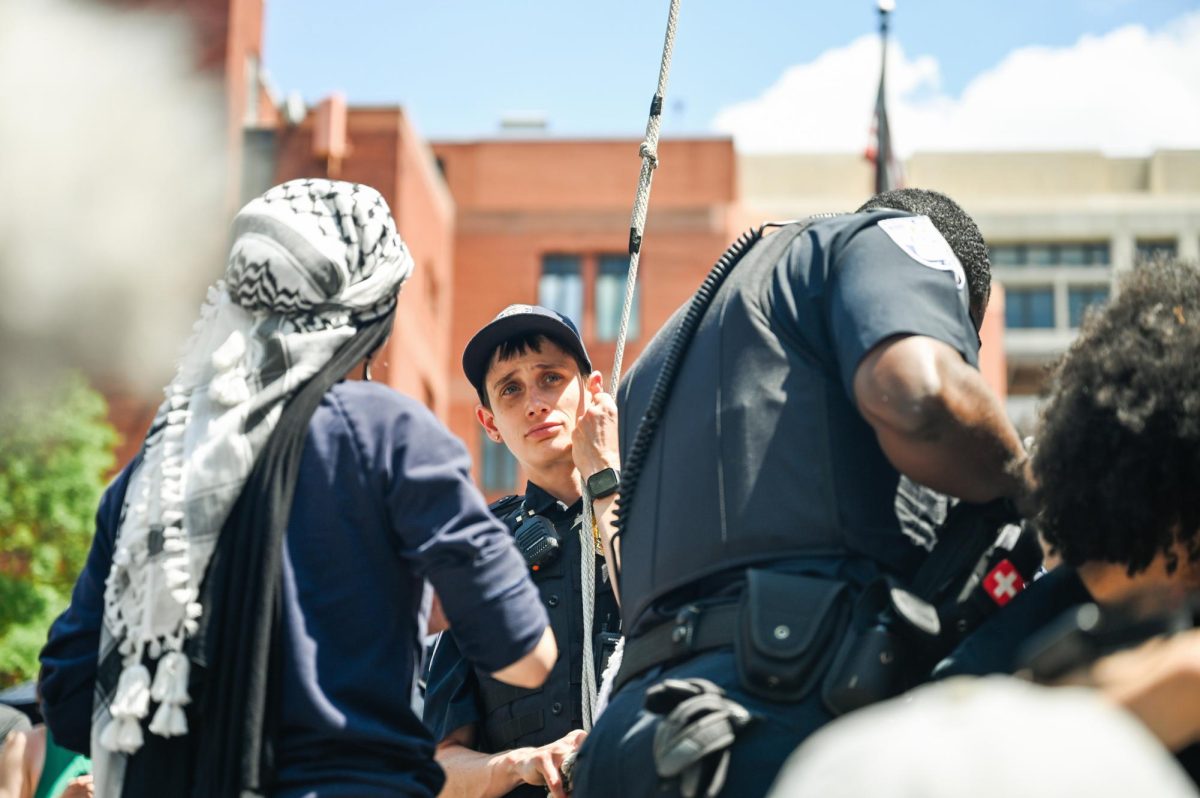The GW Police Department faces more than five months of turnover and leadership vacancies at the completion of its contentious three-phase plan to arm 22 officers with 9 mm handguns.
In April, GWPD Chief James Tate said the department planned to fill three supervisor vacancies but cited a regional and national trend of fewer applicants with less experience as reason for a potential hiring lag. Since then, the department has turned over three senior leaders and faces vacancies in some of its 22 armed officer roles, meaning despite officials’ announcement earlier this month of the end of GW’s arming implementation plan, the number of armed officers falls short.
Former Lieutenant Christina Hunsicker left GWPD in August after working at the University for more than a decade, moving up the ranks from an officer in December 2013 to a corporal in June 2018, a sergeant in December 2019 and then a lieutenant in March 2023.
Hunsicker was the sole officer in the department’s senior leadership to precede Tate’s hiring in January 2020. Prior to Tate, GWPD changed its leader four times in about two years.
Former GWPD Chief RaShall Brackney and former Assistant Chief Michael Glaubach resigned simultaneously in early 2018. The resignations prompted interim Chief Bessie Burrus to take over until officials hired Darell Darnell as superintendent of police in April 2018. Darnell suddenly left the department in March 2019, and Mary Paradis, who was serving as assistant chief of police, headed the department on an interim basis until officials hired Tate.
At an October 2020 Faculty Senate meeting, Tate detailed his plans to expand entry-level police officer requirements, saying at the time that GWPD was “not in line with best practice across the country.” The department previously hired officers after applicants passed a psychological test and a “medical/physical,” but Tate said at the October meeting that applicants should also be required to take physical and written exams.
Tate then said the department would begin requiring applicants to sit before a panel of officers, staff, students and potentially faculty members, adding that other institutions include students in interviewing stages of hiring processes, but GWPD previously failed to adopt the measure.
Hunsicker’s departure comes after former Lieutenant Sean Brown — who served at the University since March 2022 — left the department in May, and former Captain of Operations Gabe Mullinax departed in April after about two years at GW. Mullinax was one of the first two officers armed in September 2023.
As lieutenants, Hunsicker and Brown served in the department’s third-highest rank, while Mullinax occupied a role in the second-highest position under Tate. Officials filled Mullinax and Brown’s vacancies by hiring Captain George Davis and Lieutenant Cheryl Crawley this summer, but the department’s senior leadership holds one lieutenant vacancy, according to GWPD’s website.
Tate declined to comment on how many of the department’s 22 armed officer positions are vacant and if turnover within the GWPD senior leadership impacts how the department trains armed supervisors or other operations.
“As with any police force or organization, staffing fluctuates from time to time for a variety of reasons, and we continue to successfully manage our staffing to ensure we fulfill our mission,” Tate said in an email.
GWPD doesn’t list any job postings on its website, but in June, the department listed four job postings on GW’s Human Resource Management and Development page: a police lieutenant, a police sergeant — which ranks just below the lieutenants — a police corporal and a police officer.
The lieutenant posting called for candidates who can “maintain proficiency” with firearms, weaponry and police equipment and listed a salary range of $82,689.32 to $111,583.60.
GWPD announced in June 2023 that officers must undergo a 56-hour firearms course and use a virtual reality simulator to prepare for arming. The department announced in September 2023 that arming officers would cost GW about $150,000.
Tate declined to comment on how long it would take new hires to complete training, how much it costs GWPD to put an officer through the 56-hour training and if there are any equipment-associated costs needed to train armed officers.
Officials announced the Board of Trustees’ decision to arm about 20 supervisory officers with handguns in response to growing national gun violence in April 2023, a decision met with outcry from students and faculty via letters and protests.
GWPD armed its officers in three phases — arming the department’s top two officers in September 2023, five additional officers in February and the rest of the 22 supervisors, barring vacancies, early this month.
GWPD initially planned to initiate the final arming phase in April but pushed it back to July after officials canceled the first Campus Safety Advisory Committee meeting because it coincided with the first day of the pro-Palestinian encampment in University Yard on April 25. Officials rescheduled the CSAC meeting for July 24, and Tate said in July that officials wouldn’t arm the remaining officers until the committee held its first meeting.
GWPD also delayed phase two — arming five officers — from September to February because Tate said the department “didn’t want to rush things,” especially amid frequent student protests on campus in fall 2023 following the onset of the war in Gaza.
“I am proud of the dedicated officers who serve on our force and confident in their abilities to protect our community,” Tate said in an email last week.





